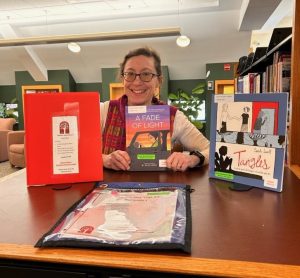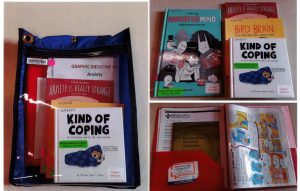Oct
21

Posted by Sarah Levin-Lederer on October 21st, 2024
Posted in: Graphic Medicine, Member Spotlight
Tags: Community of Interest, graphic medicine, Member Spotlight, public libraries
Today’s blog is a guest spot written by Tatjana Saccio, Reference Librarian at the Nevins Library and a member of the R7 Graphic Medicine COI.

Tatjana Saccio, Reference Librarian, with a Graphic Medicine Kit example.
I have been a Reference Librarian at the Nevins Library for 17 years. The Nevins Library, built in 1883, has long been considered the “heart and center” of the City of Methuen, a gateway city 30 miles north of Boston, Massachusetts. We provide service to nearly 53,000 residents of Methuen, as well as the surrounding cities/towns in the Merrimack Valley.
I am excited about the recent work we are doing at the Nevins Library to promote digital literacy, Spanish language programming, a You Belong Here initiative to provide a welcoming environment for all library users, and, of course graphic medicine.
I developed a new, innovative collection of Graphic Medicine kits that combines graphic novels on behavioral health issues with reliable and accessible consumer health information.
The COVID-19 pandemic exposed the silent epidemic of loneliness and an escalating mental health crisis in our communities. In reaction to the local health centers startling statistics on behavioral health and the dearth of out-patient services in Methuen, the former Mayor created a Mental Health Task Force of community organizations, including the Nevins Library, to collaborate on finding solutions to these problems. Thanks to the NNLM and the Consumer Health Information Specialization program, I was introduced to the field of graphic medicine. I learned that graphic medicine can be a great, non-threatening way to inform, destigmatize, and promote discussion on health and wellness issues. Inspired by the NNLM Region 7 Graphic Medicine Book Discussion kits, I created a different kind of kit targeted to individuals who are experiencing behavioral health issues, and for their loved ones who want to better understand or for health professionals to use as a tool to prompt discussion of difficult subjects.

Our kits combine 2-4 health-related graphic novels, appropriate for adults and mature teens with consumer health materials from MedlinePlus, and other trustworthy organizations. The printed health materials, including wallet cards from the Massachusetts Behavioral Health Hotline and other crisis hotline numbers, are corralled in a folder and may be kept by the kit’s reader. These materials are replenished by the Library when the rest of the kit is returned.
I started with three kits last Fall, and we are currently up to nine kits that address such topics as depression, anxiety, dementia, bipolar disorder, trauma, addiction, and postpartum depression. We have had positive feedback on this initiative, so kits on other health issues relevant to our community will follow.
My goal with these kits is to raise awareness of graphic medicine within our community and how it can be used to destigmatize mental health issues, create empathy, and encourage open dialog; and to promote health literacy in general.
One of the lessons I have learned is that if a kit does not return, the attrition has an impact as the collection is small and the kits are expensive to replace. I have also found that unless a graphic novel is new, or a bestseller, it can be difficult to acquire or replace. Another thing to consider when developing a kit like this is the time spent gathering materials, reading and selecting the graphic novels. That said, the interest in the kits and positive comments from patrons have made this project totally worthwhile.
NNLM Region 7 and the Graphic Medicine Community of Interest (COI) have been instrumental in inspiring these kits and in continuing my education with the emerging field of graphic medicine.
I use materials from NLM’s MedlinePlus as part of the consumer information in the kits because it offers current and accurate information on disorders and other health issues in an accessible format that can be printed and is available in other languages.